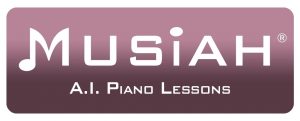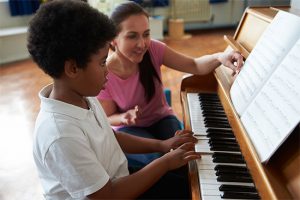
It’s never too early to teach your child to play the piano. After all, Mozart started playing when he was just four! But before you look into digital pianos for children and discover whether your child is a piano-playing prodigy, there are a few key factors to look at:
Table of Contents
- When Should Kids Start Taking Piano Lessons?
- What Are the Benefits of Children Learning Piano?
- Can a Child Learn to Play Piano on a Keyboard?
- What are the Best Online Piano Lessons for Kids?
- How Can I Teach my Child to Read Piano Sheet Music?
- How to Plan a Piano Lesson for Kids?
When Should Kids Start Taking Piano Lessons?
Children under the age of five may show interest in listening to music, dancing and playing with musical toys. However, they lack the hand size and dexterity to actually play the piano. Around this time, it is best to just encourage your child’s interest in music by, say, enrolling them in a nursery musical program.
When Your Child is ready to Start Playing

Children between the ages of 5-9 years start developing the basic skills required to learn how to play the piano. Here is everything you need to consider before you start trying to teach them how to play:
- Your child should be capable of placing all five fingers on five adjacent keys at the same time. Some children may be able to do so at the age of 5, but for others, this may take another couple of years.
- Your child should be able to move individual fingers independently.
- Your child should actively be interested in learning how to play the piano. Trying to force them into it definitely won’t help lessons progress any faster.
Research indicates that around this time, the development of a child’s language, motor skills and cognitive thinking is heightened. This makes it an ideal time to learn how to play.
Should Your Child Know How to Read Before You Teach Them How to Play?
Children may be taught how to play the piano with the help of musical books or through an ear-based method. If you’re following the books, you’ll need to wait till your child is at least 7-8 years old and can read. Otherwise, you can start teaching them when they’re 5-6 years old.
What Are the Benefits of Children Learning Piano?

Although you can learn how to play the piano no matter how old you get, it’s better to get started at a younger age. Children’s brains have the ability to soak up complex skills faster and better.
Research indicates that musical education increases your child’s abilities to comprehend. It can aid them in:
- Learning mathematical concepts,
- Fine-tuningtheir general motor skills,
- Improvinghand-eye coordination,
- Becomingmore confident overall.
There have been many cases where special needs children have become skilled at playing musical instruments. This is despite the fact that they may be having difficulty in other areas such as communication.
Can a Child Learn to Play Piano on a Keyboard?

Yes! Not everyone can go shopping and come home with a baby grand (that costs a few thousand dollars). You can get your hands on a digital keyboard for around USD 500-1000. For many, even this is a large sum so some people opt for electronic keyboards. These can easily fit a budget of a few hundred dollars.
However, electronic keyboards do not have weighted keys (a huge benefit for someone who is learning how to play) and they do not come with a stand and desk. This means that the height between the pianist’s hands and the keyboard may be uncomfortable.
You can start out with an electronic keyboard. As your child’s lessons progress and their interest develops some more, consider investing in a digital piano. There are options to buy one second hand (for instance, from thrift stores or flea markets). It’ll take some effort, but it will be worth it when you hear your child play!
What are the Best Online Piano Lessons for Kids?
The internet has made your job easy. Instead of sitting with your child by the piano for hours, trying not to lose your patience, you can enroll them in online courses. There are plenty of options to choose from. We’ll mention some here so that you’re not drowning completely in a list of supposedly brilliant piano-learning websites.

While Playground Sessions caters to budding pianists of any age, it is particularly great for children. This is because the program bases learning piano skills with the help of your favorite songs. If children play along to the music they are already familiar with, they are likely to pick up the skill much faster.
The lessons can be taken whether you have a traditional piano or a keyboard, which is ideal for people who’ve started out with a basic keyboard.

As the name indicates, Piano For All is suitable for pianists of all ages at all skill levels. It offers various methods of learning, such as through eBooks, video lessons and audio lessons. They are compatible with practically any device. Their programs will teach your children the basics, such as learning how to read music and the ability to play practically any song.

This one made it to the list because it has piano programs that are designed specifically for children. The sessions are interactive, creative and animated to captivate your child’s interest. Moreover, a child can learn at his/her own pace and truly develop their piano-playing skills.
How Can I Teach my Child to Read Piano Sheet Music?

Teaching children how to read music can be a task and a half. However, if you break it down into steps, your child will actually be able to understand what is happening and learn much faster.
The first step is to learn the basic music notation. Note time values can be learned through rhythm games or a famous method known as the clock song. Both these methods engage a child’s interest and help them understand and retain what they’re learning.
The next step is to learn the names of the notes. Whether you use colors, the alphabet, or even get creative and use different animals, there are many different ways to help your child memorize the order of the notes. Having something to look at and recall by helps children learn faster.
Now, for the age old sing along- Do-Re-Mi. Whether you’ve used it in your 2nd grade music class or heard your grandfather singing it as you go to bed, this method is a very popular way of helping students “hear” the music in their heads. It helps children mentally visualize the sound of the note before it is played and is used to string together a tune.
The final stage (and also the trickiest one) is understanding the staves and the clefs. Staves and clefs need to be explained visually in front of the keyboard. It’s harder to read them. This is because unlike regular words, notes go up and down. However, with a little patience and practice, you can get your child to the point where they’ll be able to read music as easily as their bedtime storybook.
How to Plan a Piano Lesson for Kids?
If you’ve ever been stuck in a meeting that just seemed to go on forever, you’ll find it easy to understand that children have a shorter attention span than adults. The world is still exciting and new, and if your lessons aren’t interesting enough, your child will get bored and move on to the next “fun” thing around them.
The most important thing to remember is to be patient. If your child is acting up during lessons, find ways to engage their attention. Ideally, it is recommended that you should start your children on a full-size keyboard (with 88 keys). For the first one or two times, let your child play around with the keys and familiarize themselves with the piano. Make sure that if you’re using an electric keyboard on a desk, the height of the desk works with the height of the chair so your child is in a comfortable position to play freely.
It’s also a good idea to make interesting short stories about the history of pianos and pianists (such as a mini introduction to Mozart), so that they have some motivation to start playing themselves.
Play their favorite song (or nursery rhyme) on the piano and have a little sing-along. Your child will be eager to learn their favorite song and lessons will progress much faster.
Use games to help them learn basic music terminology. Avoid bombarding them with too much in one go. Your child won’t become a prodigy overnight. Allot separate days where you just teach them basic musical notes.

It’s entirely likely that for the first few lessons, your child only uses their index finger to play. That’s okay. They’ll learn at their own pace. Since they’re still developing their motor and cognitive skills, they may also take time learning how to play separate notes with different hands. Initially, their brain is wired in such a way that one hand mimics the other’s behavior.
Just make sure that your lessons are fun and that your child is having a good time.
